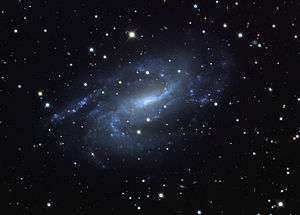NGC 925
| NGC 925 | |
|---|---|
|
NGC 925 imaged with the 32 inch telescope at Mount Lemmon Observatory | |
| Observation data (J2000 epoch) | |
| Constellation | Triangulum |
| Right ascension | 02h 27m 16.913s[1] |
| Declination | +33° 34′ 43.97″[1] |
| Redshift | 553 ± 3 km/s[2] |
| Helio radial velocity | 564[3] km/s |
| Distance | 30.3 ± 2.3 million light years (9.29 ± 0.69 Mpc)[4] |
| Group or cluster | NGC 1023 Group[5] |
| Apparent magnitude (V) | 10.7[2] |
| Characteristics | |
| Type | SB(s)d[3] |
| Apparent size (V) | 10′.5 × 5′.9[2] |
| Other designations | |
| PGC 009332, UGC 01913[2] | |
NGC 925 is a barred spiral galaxy located about 30[4] million light-years away in the constellation Triangulum. The morphological classification of this galaxy is SB(s)d,[3] indicating that it has a bar structure and loosely wound spiral arms with no ring.[6] The spiral arm to the south is stronger than the northern arm, with the latter appearing flocculent and less coherent. The bar is offset from the center of the galaxy and is the site of star formation all along its length. Both of these morphological traits—a dominant spiral arm and the offset bar—are typically characteristics of a Magellanic spiral galaxy.[7] The galaxy is inclined at an angle of 55° to the line of sight along a position angle of 102°.[3]
The galaxy is a member of the NGC 1023 Group, a nearby, gravitationally-bound group of galaxies associated with NGC 1023.[5] However, the nearest member lies at least 650,000 ly (200,000 pc) distant from NGC 925. There is a 10 million solar mass (M☉) cloud of neutral hydrogen attached to NGC 925 by a streamer. It is uncertain whether this is a satellite dwarf galaxy, the remnant of a past tidal interaction, or a cloud of primordial gas.[8]
References
- 1 2 Skrutskie, M. F.; et al. (February 2006), "The Two Micron All Sky Survey (2MASS)", The Astronomical Journal, 131 (2): 1163–1183, Bibcode:2006AJ....131.1163S, doi:10.1086/498708.
- 1 2 3 4 "NASA/IPAC Extragalactic Database". Results for NGC 925. Retrieved 2008-12-28.
- 1 2 3 4 Martin, Pierre; Roy, Jean-Rene (April 1994), "The influence of bars on the chemical composition of spiral galaxies", Astrophysical Journal, Part 1, 424 (2): 599–614, Bibcode:1994ApJ...424..599M, doi:10.1086/173917.
- 1 2 Silbermann, N. A.; et al. (October 1996), "The Hubble Space Telescope Key Project on the Extragalactic Distance Scale. VI. The Cepheids in NGC 925", Astrophysical Journal, 470: 1, Bibcode:1996ApJ...470....1S, doi:10.1086/177845.
- 1 2 Tully, R. B. (April 1980), "Nearby groups of galaxies. I - The NGC 1023 group", Astrophysical Journal, Part 1, 237: 390–403, Bibcode:1980ApJ...237..390T, doi:10.1086/157881.
- ↑ Buta, Ronald J.; et al. (2007), Atlas of Galaxies, Cambridge University Press, pp. 13–17, ISBN 0521820480.
- ↑ Pisano, D. J.; Wilcots, Eric M.; Elmegreen, Bruce G. (August 2000), "Structure and Star Formation in NGC 925", The Astronomical Journal, 120 (2): 763–776, arXiv:astro-ph/0004219
 , Bibcode:2000AJ....120..763P, doi:10.1086/301464.
, Bibcode:2000AJ....120..763P, doi:10.1086/301464. - ↑ Pisano, D. J.; et al. (June 2007), "An H I Survey of Six Local Group Analogs. I. Survey Description and the Search for High-Velocity Clouds", The Astrophysical Journal, 662 (2): 959–968, arXiv:astro-ph/0703279
 , Bibcode:2007ApJ...662..959P, doi:10.1086/517986.
, Bibcode:2007ApJ...662..959P, doi:10.1086/517986.
| Wikimedia Commons has media related to NGC 925. |
Coordinates: ![]() 02h 27m 16.9s, +33° 34′ 45″
02h 27m 16.9s, +33° 34′ 45″

